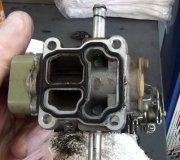My Honda 1.4 IS October 1999 never had any issues. Was 5 years unused parked in Italy. Then I droved it to Finland always parked outside. When cold came (1st day below zero centigrade) the engine yellow light would switch on, the car would be driving hiccuping until engine had warmed up. Drove to work few miles, parked it outside at minus temperature for 8 hours but the problem wouldn't occur on the way home. Now I moved back to Milan, the engine yellow light switches off always during summer and the car has no problems in summer.
This winter when it went cold the light went on. Until last week it stopped driving. We replaced the spark plugs and didn't start working immediately. Towed to Honda, mechanics switched it on and it started no problems a part the not being able to pass the 3500 RPM not in gear driving nor in idle when accelerating. The yellow light indicated the black box (the unit) but the Honda mechanics said they never saw one going bad in 20 years so they didn't do much and released the car. Now I don't really trust the car so I'd like at least to try out something before sending 'her' to the scrap yard.
SPONSORED LINKS
Saturday, January 18th, 2014 AT 11:07 PM



